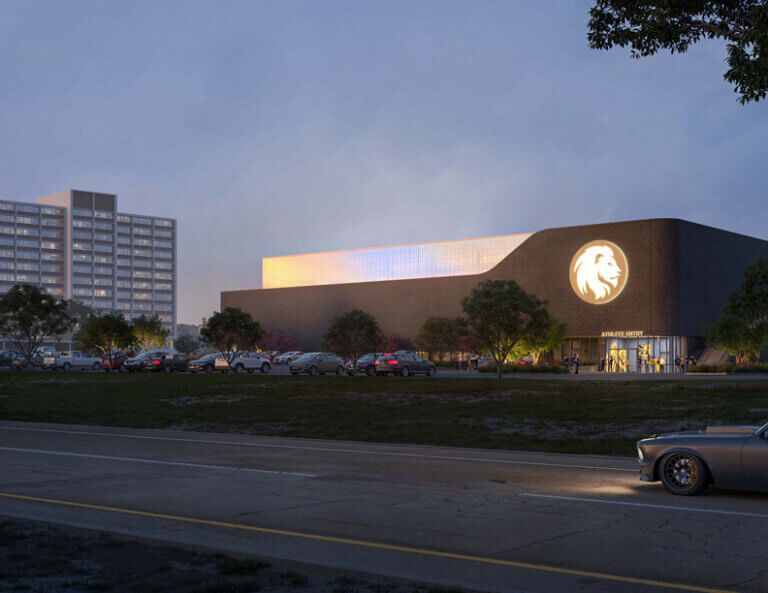
This article originally appeared on Business Alabama.
80-year-old Hoar Construction has the perspective to see what works and what needs to be fixed in today’s construction industry.
Now in its 80th year in business, Hoar Construction, recording $1 billion in revenue, has been rolling out a rebranding campaign that emphasizes the company’s commitment to improvements in process and innovation.
It’s not just the usual corporate hurrah. It comes with a determination to rise above some persistent shortcomings of the construction industry itself.
“Our identity represents the commitment Hoar Construction is making to continually evolve as a builder while doing our part to fix a broken industry,” says Turner Burton, president of Hoar. “Through the years our industry has experienced a series of highs and lows, but our process-driven approach has been our guiding principle throughout.”
With a company history that dates to the 1940s, when it built 45 churches in the Birmingham area, Hoar has grown to 600 employees nationwide working in nine market sectors and a widening geographic reach that, most recently, includes the opening of offices in Texas, Florida, Tennessee, Atlanta and Washington D.C. The company has completed more than 4,000 projects, in industry sectors that now include hospitality, multi-family, industrial, healthcare, government and entertainment.
With its history and growth, the company has a keen perspective on how the construction industry has developed over the years.
Not enough development in terms of efficiency, says Burton, whose father and grandfather preceded him in running the company. He was named president in August, 2018.
“The construction industry is one of the most inefficient industries across the board,” says Burton. “If you are studying what is going on and looking at the waste there is and how much rework goes on, 50 percent of what is being done is wasted. It is the only industry that has not invested in solving its inefficiencies in the last 50 years, compared, for example, to manufacturing and agriculture.”
At the heart of the failures, says Burton, is failure to communicate clear goals and standards from the start of a project. Competitiveness within the industry creates a culture of confidentiality, and the fast pace of developers overruns basic planning. The result is a breakdown in basic communications.
“The teams — the end user, the owner-developer, architect, engineer and the builder — do not spend enough time setting clear goals. There is not enough collaboration on the front end,” says Burton.
“You have to take the time to build a process of communication and a process of managing expectations — spending more time on the front end setting clear expectations and building in accountability and maintaining those goals on the short term basis, every day, managing for the client to see that, at the end of the day, you hit their goals in terms of speed to market and quality and cost.”
As to why the industry has been driven in this direction, says Burton, “I think it’s the pace that everybody wants to run at today. The client and the architect often put the drawings out when they are not complete. And clients often are focused on price, rather than getting it all rolled out in the beginning.
“Everything is done quick. The developer gets a piece of land and squeezes the schedule as much as possible and ends up building while the design is going on. A lot of it goes back to the fast-track concepts of the ’80s. They were looking at the interest rates and the carrying costs, focused on getting the job done as quickly as possible. But now, with the rates down, there is more opportunity to plan the work and get it right.”
Burton acknowledges that the industry has tried to address these problems over the years, with the development of laboriously detailed processes such as Integrated Project Delivery, a concept of multi-party collaboration sponsored by the American Institute of Architects in 2007. The IPD process includes contractual obligations that bind team members to shared risks and profits. But the final answers, says Burton, may be both more basic and simpler.
“Today you have legal contracts, like the IDP contract, that address shared savings and shared risks, which helps, but it’s almost a shame that it has gotten to that point.
“Since the last economic downturn, we’ve seen more clients and architects realizing the need for the contractor to be involved early in the process to help steer the process. Our projects have been trending in the right direction. Schedules are hit and costs are down, with better planning and offsite prefabrication and other innovative ways to reduce waste.”
Prefabrication, says Burton, is speeding the efficiencies with modular housing units, hotel units and apartment units built offsite. “This seems to be more and more of a focus with private equity or venture capital getting into that space. And it will continue, especially in a labor market that is as tight as it has been in the last four or five years.”
Improved job estimating software has also helped, he says, though he sees that as less important in cost efficiencies than old-fashioned direct communication. “It all comes back to communication as a team and designing as early as possible to get a complete estimate. It’s the people part that needs the most improvement, constant communication. The jobs that are able to do that are the jobs that are most successful.
“It can be as simple as getting everyone in a room together — the big room concept — and engaging collaboratively with an eye on the budget and the targets you’re trying to hit. The last five months have shown what we can do remotely, and we have had some great successes using a Microsoft platform to coordinate, but I will still maintain that it is never as good as meeting face-to-face.”

